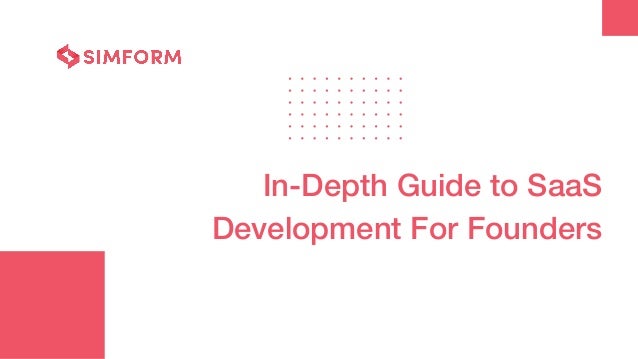
SaaS Development.pdf
- 1. In-Depth Guide to SaaS Development For Founders
- 2. Table of content What is SaaS development? What is SaaS application development? Things to consider before developing a SaaS application Steps to develop SaaS solutions? Cost of SaaS app development Challenges of SaaS software development
- 3. SaaS (Software as a Service) is a software licensing and delivery model where you host the application on the cloud. The software is licensed on a subscription model, accessible to users through the internet anywhere and in any time zone without installing it. What is SaaS development?
- 4. 1. Technical considerations Things to consider before developing a SaaS application Monolithic Microservice Single-tenant Multi-tenant a.) SaaS architecture Carefully design your software architecture and take help from the solution architects who have the skill and experience to solve a complex problem. Here are some popular types of SaaS architectures that one can choose from: b.) Tech stack The tech stack comprises programming languages, server technology, database, cloud hosting provider, CDN (Content Delivery Network), etc. c.) Third-party integrations The tech stack comprises programming languages, server technology, database, cloud hosting provider, CDN (Content Delivery Network), etc.
- 5. 1. Technical considerations Things to consider before developing a SaaS application Payment system Secure database No downtime deployment Subscription lifecycle management d.) Core features There are a few must-have features you will need in any SaaS application. Let’s analyze them: Project manager UI/UX designer Business analyst Back-end developer Front-end developer QA engineer e.) SaaS development team Here are some of the designations you would require in a SaaS development team:
- 6. 1. Technical considerations Things to consider before developing a SaaS application ToeDipper SurvivorTech UnicornExpress New Horizons f.) SaaS development framework With years of experience in helping SaaS startups, AWS has developed a SaaS journey framework consisting of four categories.
- 7. 2. Non-Technical considerations Things to consider before developing a SaaS application a.) Market research A clear understanding of the market will help you know if there’s a unique challenge that your targeted customers would like to be solved. Flat-Price Usage-Based Tiered-Pricing Per-User Pricing Per Active User Per-Feature Pricing Freemium b.) SaaS pricing models The monetization model of any SaaS company becomes the base for their future earnings. Here are some of the most popular SaaS pricing models: Penetration Pricing Captive Pricing Skimming Pricing Prestige Pricing Free-Trial Pricing c.) SaaS pricing strategies Pricing strategies define the approach you should use to describe the SaaS product. Here are popular SaaS pricing strategies:
- 8. Steps to develop SaaS solutions? 1: Requirement analysis and planning 4: Deployment 2: Designing 5: Testing and maintenance 3: Development 6: Optimization
- 9. The average cost to build a SaaS MVP lies somewhere between $20,000 and $70,000. The full-fledged app development may cost you somewhere between $80,000-$200,000. Cost of SaaS app development
- 10. Here is the cost calculation according to various factors: 1 As per development phases: Cost of SaaS app development
- 11. Here is the cost calculation according to various factors: 2 As per team type: Cost of SaaS app development
- 12. Scalability: If it’s not scalable, your SaaS business can’t grow. So, choose a tech stack that can quickly scale soon. Security: The personal information of customers should have a high level of encryption. Reliability: Choosing trustworthy partners for your servers, programming language, database, cloud infrastructure, etc., can lead to higher reliability. Monetization: Choosing suitable SaaS pricing models and strategies discussed above is essential. If you get that right, you are on the right track. Challenges of SaaS software development
- 13. Contact Us Email Address contactus@simform.com Website www.simform.com Social Presence twitter.com/simform facebook.com/simform linkedin.com/company/simform/
